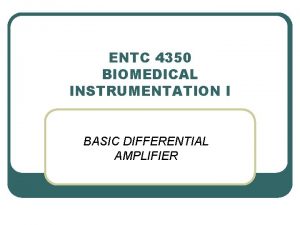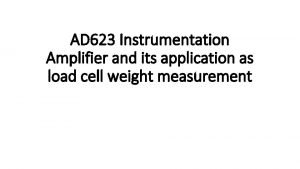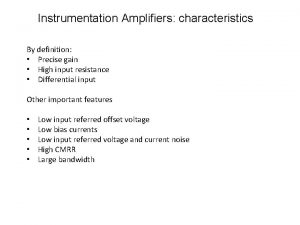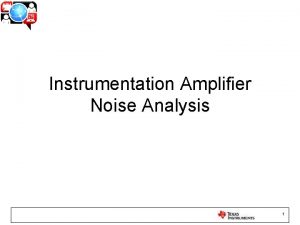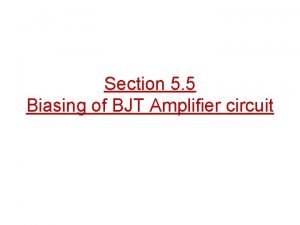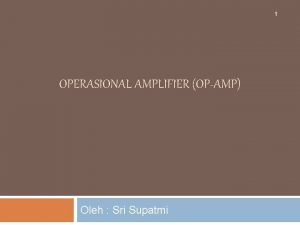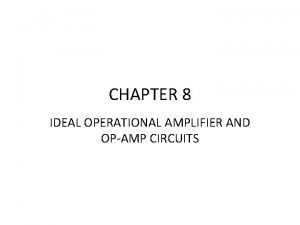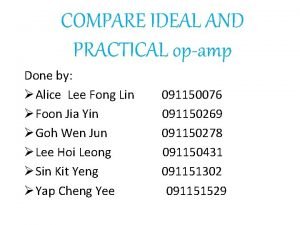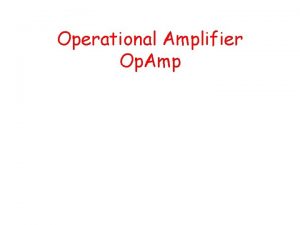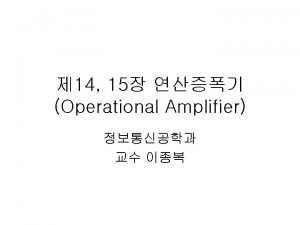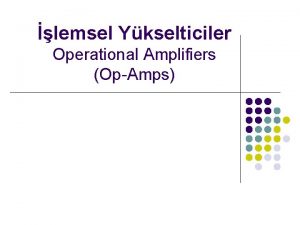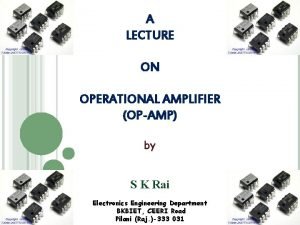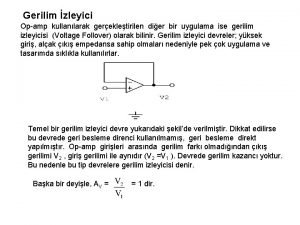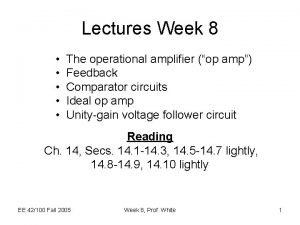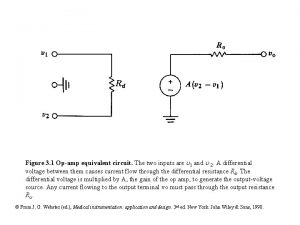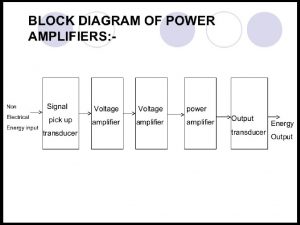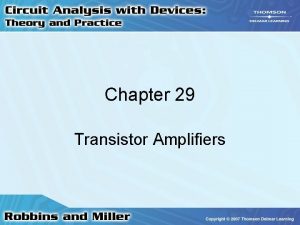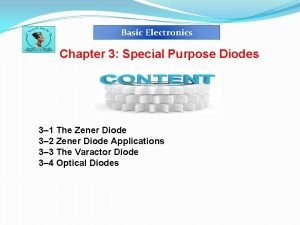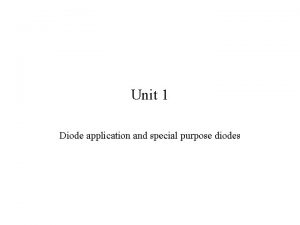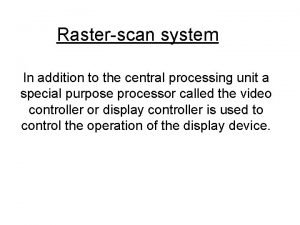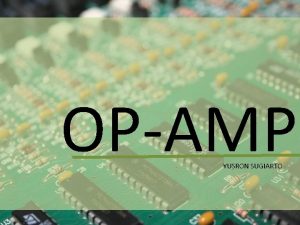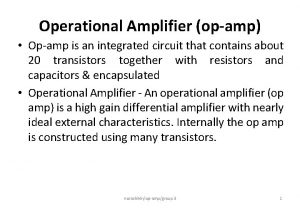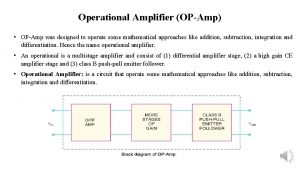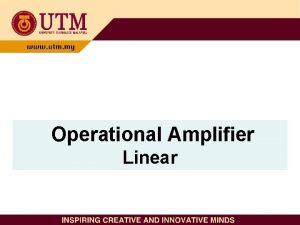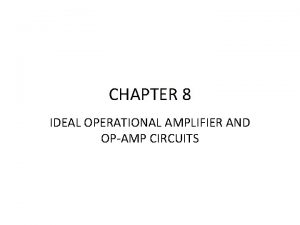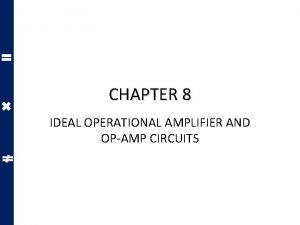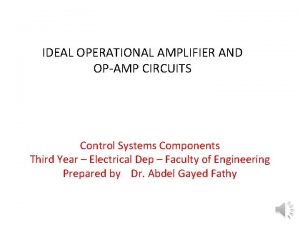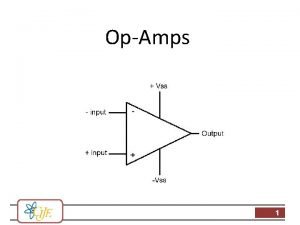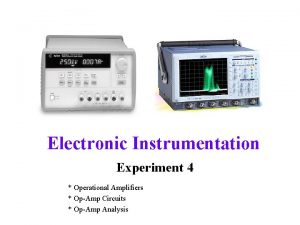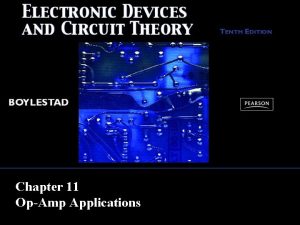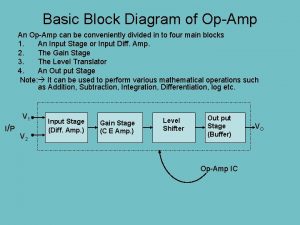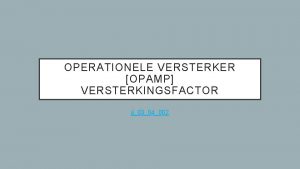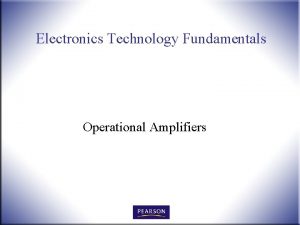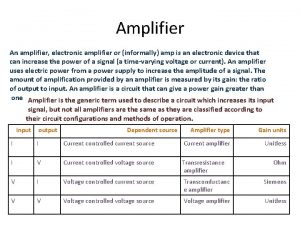SPECIAL PURPOSE OPAMP CIRCUITS Instrumentation Amplifier Isolation Amplifier
































- Slides: 32

SPECIAL PURPOSE OP-AMP CIRCUITS Instrumentation Amplifier Isolation Amplifier Operational Transconductance Amplifier Log/Antilog Amplifier Analogue Electronics II (ENT 216)

Instrumentation Amplifier Instrumentation amplifier is a differential voltage-gain device that amplifies the difference between voltages at its two input terminals. The purpose is to amplify small signals riding on large common mode voltages. High input impedance, high common-mode rejection, low output offset and low output impedance. Analogue Electronics II (ENT 216) 2

Instrumentation Amplifier Analogue Electronics II (ENT 216) 3

Instrumentation Amplifier Analogue Electronics II (ENT 216) 4

Instrumentation Amplifier A 1 and A 2 are non-inverting configuration. A 3 is used as a unitygain differential amplifier. R 3 = R 4 =R 5 = R 6. RG is gain setting resistor. Signal to A 1 is non-inverting. The voltage gain is Analogue Electronics II (ENT 216) 5

Instrumentation Amplifier Input to inverting terminal of A 1 is Vin 2 and amplified by A 1 by gain of Overall closed-loop gain of instrumentation amplifier is where R 1 = R 2 = R. Analogue Electronics II (ENT 216) 6

Instrumentation Amplifier Example: Determine value of external gain-setting resistor, RG for instrumentation amplifier with R 1 = R 2 = 25 kΩ and AV = 500. Analogue Electronics II (ENT 216) 7

Instrumentation Amplifier Instrumentation amplifier measure small differential signal voltage superimposed on common-mode voltage. It must amplify small signal and reject the large common-mode voltage. Analogue Electronics II (ENT 216) 8

Instrumentation Amplifier An example of specific instrumentation amplifier device is AD 622. Gain can be adjusted with external resistor RG. Minimum CMRR is 66 d. B. RG is selected based on equation, Analogue Electronics II (ENT 216) 9

Isolation Amplifier An isolation amplifier provides dc isolation between input and output. Used for protection of human life or sensitive equipment especially from hazardous power line leakage or high voltage transients. It is usually consist of two electrically isolated stages. The input and output stage are separated by isolation barrier. Signal must be processed in order to be coupled across isolation barrier. Analogue Electronics II (ENT 216) 10

Isolation Amplifier Analogue Electronics II (ENT 216) 11

Isolation Amplifier Optical coupling or transformer coupling is used to provide isolation between the stages. Capacitive coupling also been used by many modern isolation amplifier. Each stage has separate supply voltages and grounds. Thus, there are no common electrical path between the stages. Analogue Electronics II (ENT 216) 12

Isolation Amplifier 3656 Transformer Coupled Isolation Amplifier Analogue Electronics II (ENT 216) 13

Isolation Amplifier AD 204 Low Cost Miniature Isolation Amplifier Analogue Electronics II (ENT 216) 14

Isolation Amplifier ISO 100 Optically Coupled Linear Isolation Amplifier Analogue Electronics II (ENT 216) 15

Isolation Amplifier Analogue Electronics II (ENT 216) 16

Isolation Amplifier Transformer-Coupled Isolation Amplifier Gain of input stage Gain of output stage Total gain Analogue Electronics II (ENT 216) 17

Operational Transconductance Amplifier (OTA) is a voltage-tocurrent amplifier. Output current equals gain times input voltage. OTA has : -two input terminals -high input impedance -high CMRR -bias-current input terminal -high output impedance -no fixed open-loop voltage gain Analogue Electronics II (ENT 216) 18

Operational Transconductance Amplifier Transconductance is defined as the ratio of output current to input voltage. Voltage-to-current gain of OTA is : Transconductance in OTA can also be given as : where K is a constant and IBIAS is bias current. So, output current is controlled by input voltage and bias current Analogue Electronics II (ENT 216) 19

Operational Transconductance Amplifier Analogue Electronics II (ENT 216) 20

Operational Transconductance Amplifier Analogue Electronics II (ENT 216) 21

Operational Transconductance Amplifier Bias current for typical OTA is given by, +VBIAS may be obtained from positive supply voltage or externally applied variable voltage. Other model of OTA might have different value of voltage drop from +VBIAS to –V. LM 13700 for example has voltage drop of 1. 4 V due to the internal circuit where there is base-emitter junction and a diode. Analogue Electronics II (ENT 216) 22

Operational Transconductance Amplifier Schematic diagram for LM 13700 Analogue Electronics II (ENT 216) 23

Operational Transconductance Amplifier Schematic diagram for LM 3080 Analogue Electronics II (ENT 216) 24

Log and Antilog Amplifier Basic Logarithmic Amplifier A log amplifier produces logarithmic response. Output voltage is a function of logarithm of input voltage. K is constant. Analogue Electronics II (ENT 216) 25

Log and Antilog Amplifier The p-n junction of a diode has non-linear characteristic curve and it is logarithmic. The forward current, IF is given by, Applying natural logarithm on both sides and solve for VF , Analogue Electronics II (ENT 216) 26

Log and Antilog Amplifier Substituting into VF , k. T/q is constant equal to 25 m. V at 250 C Analogue Electronics II (ENT 216) 27

Log and Antilog Amplifier Basic Antilog Amplifier Characteristic equation of p-n junction is IEBO is emitter-to-base leakage current and Vin = VBE Since k. T/q is approximately 25 m. V, thus Analogue Electronics II (ENT 216) 28

Other Op-Amp Circuits Constant-Current Source Analogue Electronics II (ENT 216) 29

Other Op-Amp Circuits Current-to-Voltage Converter Analogue Electronics II (ENT 216) 30

Other Op-Amp Circuits Voltage-to-Current Converter Analogue Electronics II (ENT 216) 31

Other Op-Amp Circuits Peak Detector Analogue Electronics II (ENT 216) 32
 Special purpose amplifiers
Special purpose amplifiers Differential amplifier in biomedical instrumentation
Differential amplifier in biomedical instrumentation Instrumentation amplifier applications
Instrumentation amplifier applications Characteristics of instrumentation amplifier
Characteristics of instrumentation amplifier Instrumentation amplifier experiment
Instrumentation amplifier experiment Advantages of parallel circuit over series circuit
Advantages of parallel circuit over series circuit Collector bias current
Collector bias current Rumus vout op amp
Rumus vout op amp Op-amp differentiator solved problems
Op-amp differentiator solved problems Ideal & practical
Ideal & practical Apa itu summing amplifier
Apa itu summing amplifier Virtual ground op amp
Virtual ground op amp Op amp sembolü
Op amp sembolü Opamp
Opamp Open loop configuration of op-amp
Open loop configuration of op-amp Opamp
Opamp Apa itu summing amplifier
Apa itu summing amplifier Opamp equivalent circuit
Opamp equivalent circuit Difference between voltage amplifier and power amplifier
Difference between voltage amplifier and power amplifier Purpose of capacitor in transistor amplifier
Purpose of capacitor in transistor amplifier Special purpose machine bir
Special purpose machine bir Flag register in 80386
Flag register in 80386 Special purpose diodes
Special purpose diodes Introduction to analytical chemistry
Introduction to analytical chemistry Special finishes
Special finishes Special purpose diode
Special purpose diode Special purpose books are:
Special purpose books are: The mix of human and nonhuman features at a given location
The mix of human and nonhuman features at a given location Special purpose financial statements
Special purpose financial statements Special purpose diodes
Special purpose diodes Special purpose application software
Special purpose application software Architecture of simple raster graphics system
Architecture of simple raster graphics system Contoh special purpose software
Contoh special purpose software

